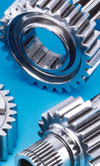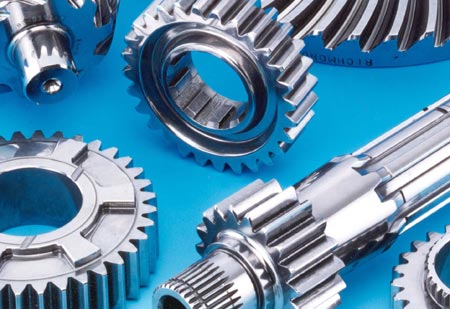Chemical processes
 There are a number of reasons why we might want to improve the level of surface finish on components for race engines and transmissions, but the chief among these are reliability and friction. By improving the level of surface finish, we generally mean reducing the level of roughness.
There are a number of reasons why we might want to improve the level of surface finish on components for race engines and transmissions, but the chief among these are reliability and friction. By improving the level of surface finish, we generally mean reducing the level of roughness.
The effect of reducing roughness on component reliability is well known, and has been quantified for a range of surface finishes from rough-cast, through machined and ground finishes to 'mirror' polishing. In all these cases, reducing roughness has an attendant increase in endurance limit.
As has been discussed previously, in the article posted in May 2011 on the subject of 'Superfinishing', reduced surface roughness helps to mitigate friction and wear in sliding contacts. In situations where oil films are very thin, the roughness of the surfaces in contact are important in determining if there will be metal-to-metal contact, how much there is and how this affects friction.
Polishing can be a purely mechanical process, either carried out in a purpose-designed machine or semi-manually, as is the case with tape-polishing of crankshafts.
However, many superfinishing processes are chemically accelerated and, as such, their success depends on how chemically reactive the parts being processed are. The processes known as ISF (Isotropic Surface Finishing) are an example of chemically accelerated superfinishing, which combine the action of chemical agents with an automated mechanical surface finishing process such as vibratory polishing.
The chemical part of the process forms a film or 'conversion' layer on the part; this process converts the very top layer of the surface to a soft state that is easily removed by the vibratory finishing process. Any asperities (peaks) have a greater surface area:volume ratio. As the surface area dictates the volume of conversion layer, we can see that this allows the vibratory finishing process to remove material preferentially from peaks. The conversion layer in the 'valleys' in the surface finish is not removed, as the size and form of the polishing media is such that they do not 'fit' in the valleys and can therefore not remove any material. As the process is repeated many times, the surface becomes increasingly smooth.

The final part of the process is called 'burnishing', which removes any remaining conversion coating in the valleys of the surface. This process is undertaken once the initial cycles of surface conversion and conversion layer removal have produced a satisfactory level of finish. After burnishing, the surface is rendered bright and shiny, as we would expect from a highly finished component.
Such isotropic finishing processes find common use in highly loaded contacts where sliding is present. Very popular applications for such processes are gears, where the process has been found to have a beneficial effect in mitigating scuffing and micro-pitting, and also in terms of friction reduction. In this case, the benefits are not only applicable to engine gears, but to transmissions. Racing transmissions have been tested and proven to benefit from such processes (see Reference). The contact between a cam and follower is also highly stressed, and is known to benefit from improved surface finish in terms of reduced friction.
Reference : Niebolo, W.P., "Harnessing the Horsepower Thief", Gear Solutions magazine, August 2006
Fig. 1 - Gears are an excellent application for chemically assisted processes to improve surface finish (Courtesy of REMChem)
Written by Wayne Ward